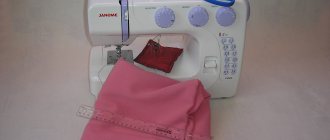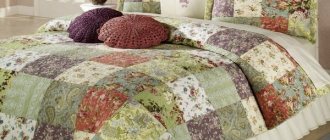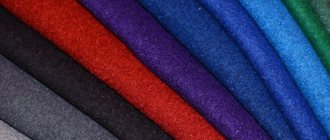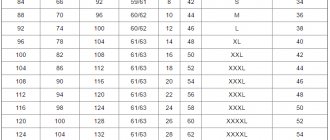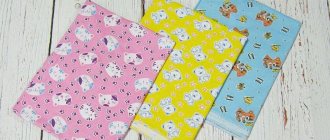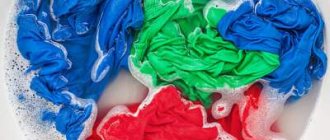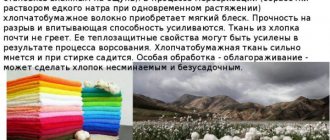Cotton
Thick cotton fabric can be made either 100% from natural raw materials or with the addition of artificial and synthetic fibers. The range of such materials is very wide; the most famous and popular are the following fabrics, obtained in various weaves:
- Twill.
It is produced with a diagonal weave, so on the front surface it has a pronounced diagonal pattern or a small herringbone rib. Twill fabric is characterized by wear resistance, strength and durability. It is used for sewing trousers, suits, workwear, curtains, and demi-season outerwear. - Moleskin.
Produced in a very dense satin weave with reinforced weft and warp threads. This is a smooth, hygroscopic, comfortable fabric, most often dyed dark. Moleskine is resistant to wear, friction and other deformations, is easy to clean and does not electrify. It is used for sewing workwear for hazardous industries, trousers and outerwear. - Velveteen.
Fabric with small or large longitudinal rib. Its name translates as “royal cloth”. This is a material with a luxurious appearance, soft, durable and almost wrinkle-resistant. Retains heat well, but requires maintenance and can shrink. Demi-season and children's clothing, trousers, and dresses are produced from ribbed fabric. Often used for sewing curtains, bags and hats. - Poplin.
A finely ribbed fabric formed by thickened weft threads. Can be painted in a wide variety of colors and patterns. Soft, durable, breathable and inexpensive material with a slight sheen. High hygroscopic properties make it possible to use poplin for the production of curtains, bed linen, casual clothing and home textiles. - Tale.
Soft fabric with pile on the reverse side. Retains heat well and hardly stretches. It is used to make children's and casual clothing. - Jeans.
Can be made using one of the twill weave types. This is a durable fabric that allows moisture to pass through and retains heat. There may be a small inclined or vertical scar on the surface. Used for sewing jeans, outerwear, shoes and bags. - Pique.
Its popular variety is called waffle fabric. The weave, which forms a pattern on the surface in the form of small honeycombs or diamonds, can be brushed on the reverse side. The fabric has an original appearance and excellent hygienic properties. This soft, practical fabric is used for sewing polo shirts, dresses and skirts, home textiles and children's clothing. - Jacquard.
Thick fabric based on linen or cotton raw materials. It has a dense structure with a relief surface. Wear-resistant, easy to care for, attractive in appearance and durable fabric.
Using a combination of cotton and artificial or synthetic fibers, fabrics with completely different characteristics can be obtained. The weaves used are the same as for pure cotton.
Silk
Several types of materials with increased density are produced from durable and delicate silk thread. Thick silk fabric has the same shine and smooth surface as more airy options. It is worth considering that these materials do not have very great heat-shielding properties .
Satin is the most popular dense silk fabric. Made with satin weave. Satin has an extremely smooth and shiny surface. The back of the fabric is matte, with a slight roughness. The atlas is characterized by the following properties:
- good hygroscopicity;
- hypoallergenic;
- does not accumulate static electricity;
- excellent drapability;
- elasticity and lightness;
- strength;
- durability.
In addition, dust particles and small specks do not settle on the satin. The material is not of interest to insects, which means it will not harbor ticks or other pests. Satin does not wrinkle, and things made from it keep their shape well.
In addition to its advantages, completely natural satin also has disadvantages. This dense silk fabric is easy to care for: it requires hand washing in cold water with special products. The satin should not be wrung out or twisted so as not to disturb the structure of the fibers.
Most often, satin is not made entirely from silk threads. Cotton, viscose, polyester, nylon, and acetate are added to the fabric composition. This expands the scope of application of the fabric. Silk satin is used for sewing dresses, elegant and casual clothes, curtains, bags, underwear and bed linen. Satin with the addition of synthetic raw materials is used for finishing furniture and decorating residential premises.
The following materials containing silk have a dense structure:
- Velvet.
Made with pile weave. This is usually a wool blend or silk fabric with piles of different lengths. Mainly used for sewing and decorating furniture, curtains, shoes, bags. The front surface can be smooth or finely ribbed (corduroy). The length of the pile can also vary. - Taffeta.
Produced by simple weaving. It has a very smooth surface with a glossy shine. This thin but dense fabric is used for sewing shirts and dresses. - Moire.
As a result of calendering, a material with a wave-like sheen is obtained. Durable, well-draped fabric is used for sewing festive clothes, curtains and decor. - Shanzhan.
It is distinguished by a wave-like color tint, which is obtained by using threads of different colors or shades for the warp and weft. Both silk and cotton fibers can be used. This smooth material with a peculiar shine is used for sewing evening and festive items. - Reps.
This dense fabric is made with a complex plain weave, which forms a fine rib on the surface. An easy-to-care material used for sewing summer and mid-season clothing, curtains and home decor.
Less popular are silk fabrics such as chesucha, brocade, faille, dama, duchess. They are used to make theatrical, historical and evening dresses. Semi-natural fabrics are used for sewing curtains, shoes, and bags.
Care
When choosing a washing mode, you should follow the instructions on the label and take into account the composition and characteristics of the material.
Useful
Dresses made of light, thin fabrics (silk, chiffon) need to be washed very carefully, and it is better to have them dry cleaned. Washing can damage the structure of the fabric, it stretches, and there is also a risk of snagging.
When choosing fabric for a summer dress, you need to be guided by several parameters, always taking into account your body type and the purpose of the outfit. Clothing at this bright and joyful time of year should be comfortable, light and bring only positive emotions.
© 2021 textiletrend.ru
Linen
The most common dense linen fabrics include:
- Crinoline.
Linen fabric with increased rigidity and density. Used as a cushioning material to give shape to clothing items. - Canvas.
Made from thick yarn, often treated with a water-repellent compound. Workwear, shoes, and bags are made from it. - Teak.
A striped fabric used for upholstery. - Matting.
Made with double or triple weave. Used for sewing everyday clothes.
In most cases, dense fabric made from linen yarn is used for sewing workwear and interior decoration.
Diving - a novelty among dense fabrics
Among the large number of materials, diving deserves attention - a dense synthetic fabric of a new generation.
Due to its ability to hug the body, diving is often called a “second skin.” This is due to the unique composition of the material - it consists of 60% polyamide, and the remaining 40% is divided between polyester and elastane.
What do they make from diving?
There are two types of this dense fabric:
- Microdiving is a smooth material from which tights, leggings, tops, and skirts are sewn. Sometimes it is used to create theatrical costumes, evening dresses, and clothing for special occasions.
- Super diving is the basis of suit fabric for swimmers, gymnasts, and athletes.
Superdiving fleece is used to sew winter clothing for skiers and climbers.
Unique diving properties
In addition to increased density and strength, diving has a number of excellent qualities:
- Wear resistance. The material does not fade, does not stretch, does not shrink or stretch. No matter how long a diving suit lasts, it retains its original appearance.
- Hygroscopicity. The fabric allows moisture to pass through perfectly.
- Breathability. Despite being completely “synthetic,” the body in diving clothing “breathes.”
- Easy to care for. The products are easily washed off from dirt and dry quickly.
- Wrinkle resistance. Diving clothing does not wrinkle and does not require ironing.
Need to take into account! The water temperature for washing diving products should not exceed 400C, otherwise the item may “shrink”. Do not use bleaches or chlorine-containing powders. It is best to dry in the shade so that ultraviolet rays do not cause the destruction of fabric fibers.
High-density fabrics are in demand in many industries. Having familiarized yourself with all their variety and characteristics, you can easily choose fabric for a new elegant dress or suit, as well as for updating your home interior.
Wool
Most wool fabrics have increased strength.
Dense wool fabric is a leader in heat-protective properties among natural fabrics.
Most often in light industry the following types of materials are used:
- Gabardine.
Made from twisted merino yarn. There is an inclined scar on the front surface. Wear-resistant fabric with a matte surface and good heat-shielding properties. This easy-to-care material has excellent drapability and hygienic properties. It is used for sewing outerwear and casual clothing, curtains, decor and workwear. - Tartan.
Woolen or wool blend fabric in a checkered pattern, also called “tartan”. Dense and warm material that is used for sewing outerwear, casual and national clothing, blankets and bedspreads. - Tweed.
Soft material made with a diagonal weave. There is a small pile on the surface. Elastic, almost wrinkle-resistant fabric with high heat and water protection properties. Outerwear, suits, skirts, and trousers are made from it. - Flannel.
Blended wool, wool or brushed cotton fabric with an inconspicuous scar on the surface. Due to its softness, it is used for the manufacture of children's and home clothing, bed linen. - Covercott.
Produced with twill weave from twisted threads. Elastic and warm fabric is used for sewing outerwear, suits and other everyday items.
In addition, the following materials are common:
- loden;
- tapestry;
- boucle;
- drape;
- cloth;
- Cheviot etc.
Other materials
Dense fabrics may include artificial and synthetic fibers and threads. Increased density is achieved mainly due to reinforced weaves.
Knitwear can also be dense if it is made from thick yarn, knitted in a double or triple weave, or has a thick pile, brushed or complex pattern . Thick cotton knitwear is called interlock. The loops of the fabric intersect, which provides additional density and strength. This is a material smooth on both sides, with excellent thermal insulation and hygroscopic properties. This knitwear has almost no stretch and is resistant to wear and deformation. It is used for sewing children's, sports, home and casual clothing.
Footer is knitwear, also made from cotton. There is a slight comb on the back side, while the front surface is smooth and dense. This knitwear has high hygienic and performance characteristics. It is used for children's, home and sportswear.
Jersey is a knitwear product formerly made from wool or containing a large amount of it. Now it is made from a wide variety of threads and fibers. This knitwear does not wrinkle, it only stretches in width. Jersey is a soft and pleasant to the touch material. Knitwear is used depending on its composition. Woolen jersey is used for sewing outerwear and warm clothing. Cotton knitwear is the basis for making children's and home clothes, silk is used for underwear.
Benefits of natural fabrics
The advantages of natural fabrics: there are a huge number of them, we will list them in order in our article.
Natural fabrics include any textile materials, the raw materials for the production of which were created by nature itself. That is why we should talk about the highest level of environmental friendliness - they do not use synthetic and chemical additives that could harm human health.
The advantages of natural fabrics also lie in the fact that they are suitable for people with allergies and those who suffer from various skin diseases and diseases of the respiratory system, in whom synthetics can cause a negative reaction.
Their widespread use in the manufacture of children's clothing is primarily due to their hypoallergenicity. It is no coincidence that various diapers, vests, rompers and other items of clothing for newborns and small children are made exclusively from cotton. For more information on our website, you can read the article “Bedding for children: tips and recommendations.”
Natural, non-natural, synthetic and artificial fabrics can be combined with each other to produce the best quality textile material. This is a common practice that produces textiles that have the advantages of natural and synthetic raw materials.
